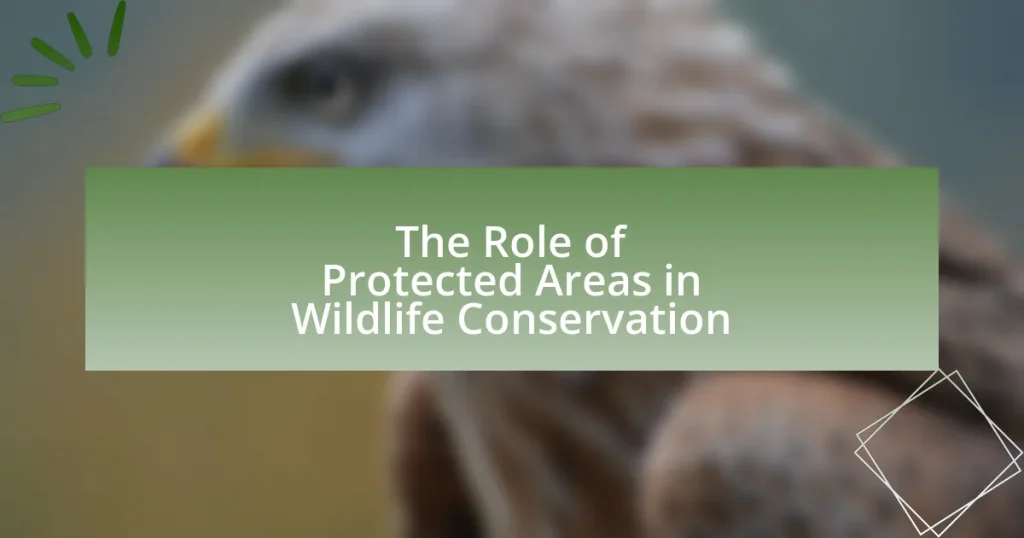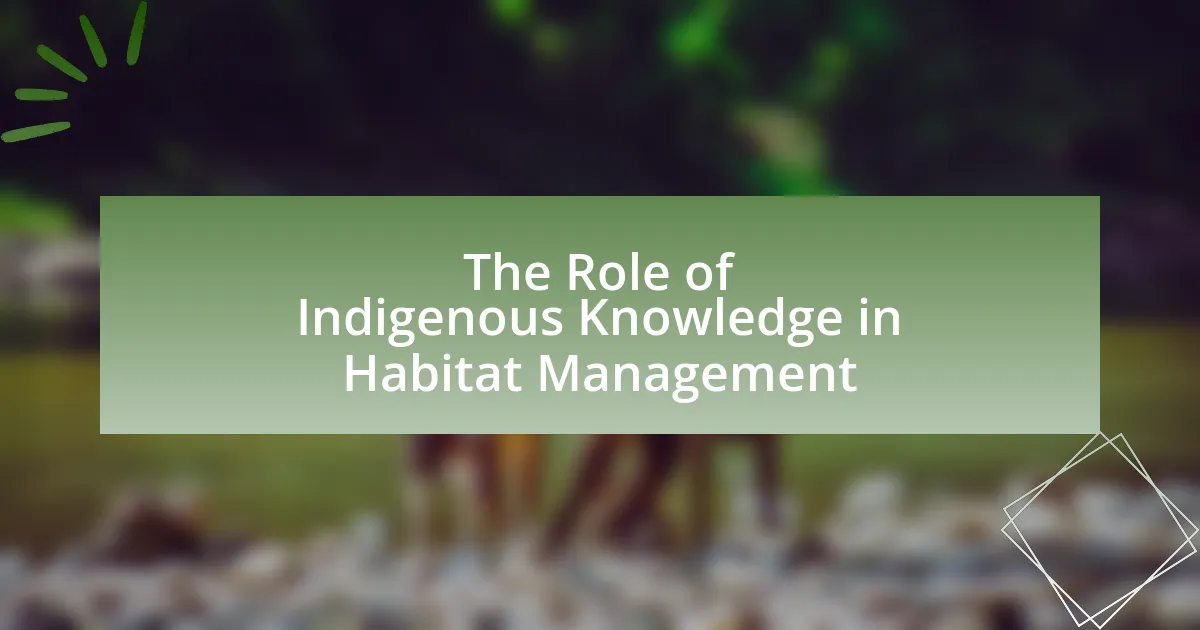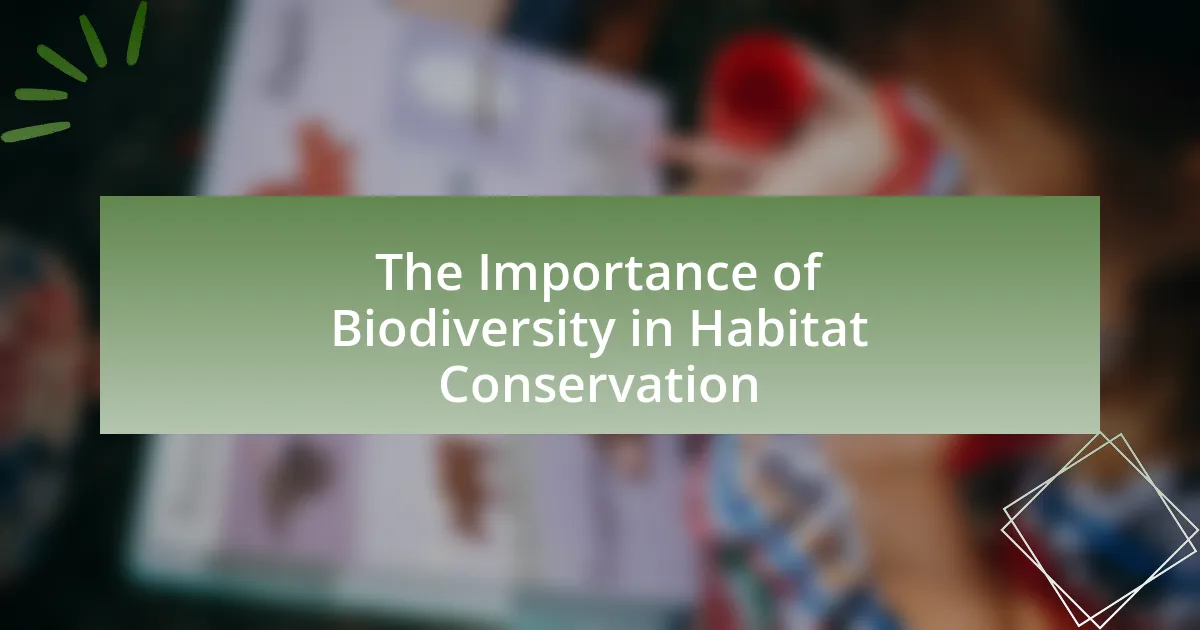Protected areas are designated regions established to conserve biodiversity and protect wildlife habitats from human activities. This article examines the critical role of protected areas in wildlife conservation, highlighting their importance in providing safe environments for various species, preserving endangered species, and maintaining ecological balance. It discusses how protected areas contribute to biodiversity preservation, the types of species that benefit, and their role in habitat restoration. Additionally, the article addresses the challenges faced by protected areas, including habitat loss, poaching, and climate change, while exploring funding issues and strategies to enhance their effectiveness through improved management practices and community involvement.
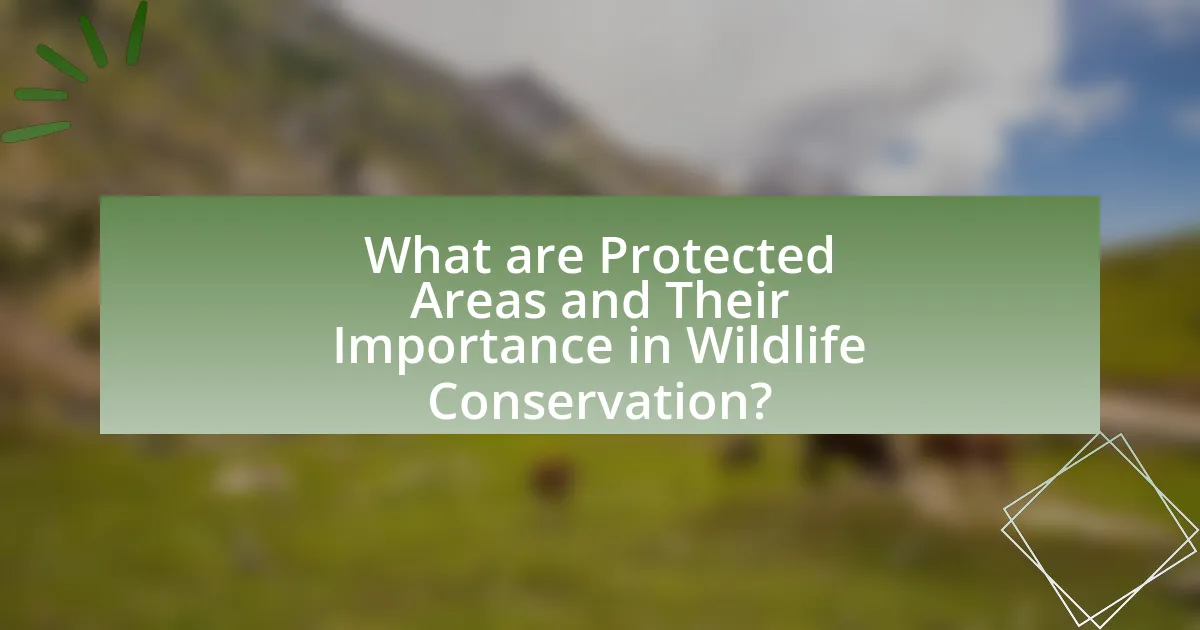
What are Protected Areas and Their Importance in Wildlife Conservation?
Protected areas are designated regions that are established to conserve biodiversity and protect wildlife habitats from human activities. Their importance in wildlife conservation lies in their ability to provide safe environments for various species, allowing ecosystems to thrive and recover from threats such as habitat destruction, pollution, and climate change. According to the International Union for Conservation of Nature (IUCN), protected areas cover approximately 15% of the Earth’s land surface and play a critical role in preserving endangered species and maintaining ecological balance. By safeguarding these areas, conservation efforts can enhance species survival rates and promote sustainable use of natural resources, ultimately contributing to global biodiversity goals.
How do Protected Areas contribute to biodiversity preservation?
Protected Areas contribute to biodiversity preservation by providing safe habitats for various species, thereby reducing the threats of habitat loss, poaching, and climate change. These designated regions, such as national parks and wildlife reserves, protect ecosystems and the species that inhabit them, allowing for natural processes to occur without human interference. According to the International Union for Conservation of Nature, protected areas cover approximately 15% of the Earth’s land surface and are crucial for conserving 80% of the world’s terrestrial biodiversity. This statistic underscores the effectiveness of protected areas in maintaining ecological balance and supporting species survival.
What types of species benefit from Protected Areas?
Protected Areas benefit a wide range of species, particularly those that are endangered, threatened, or endemic. Endangered species, such as the Amur leopard and the Sumatran orangutan, find refuge in these areas, which provide critical habitats free from human encroachment. Additionally, threatened species like the African elephant and the snow leopard gain protection from poaching and habitat loss within these designated zones. Endemic species, which are unique to specific regions, also thrive in Protected Areas as these locations preserve their natural environments. Research indicates that Protected Areas can significantly reduce the risk of extinction for these species by maintaining biodiversity and ecosystem integrity.
How do Protected Areas help in habitat restoration?
Protected Areas facilitate habitat restoration by providing a safe environment for ecosystems to recover from degradation. These designated regions limit human activities such as logging, mining, and urban development, which are primary drivers of habitat loss. For instance, studies have shown that in the United States, protected areas have led to a 30% increase in biodiversity within their boundaries, demonstrating their effectiveness in allowing native species to thrive and ecosystems to regenerate. Additionally, the establishment of protected areas can enhance ecosystem services, such as water purification and carbon sequestration, further contributing to habitat restoration efforts.
What are the different categories of Protected Areas?
Protected Areas are classified into several categories based on their management objectives and levels of protection. The main categories include National Parks, Wildlife Reserves, Nature Reserves, Marine Protected Areas, and World Heritage Sites. National Parks are designated for the protection of natural and cultural resources while allowing for public enjoyment. Wildlife Reserves focus on the conservation of specific species and their habitats. Nature Reserves are established to protect biodiversity and ecosystems, often with stricter regulations. Marine Protected Areas aim to conserve marine ecosystems and biodiversity. World Heritage Sites are recognized for their outstanding universal value and are protected under international treaties. These categories are essential for effective wildlife conservation and biodiversity preservation.
What distinguishes national parks from wildlife reserves?
National parks are designated areas that prioritize the preservation of natural landscapes and ecosystems, while wildlife reserves focus primarily on the protection of specific animal species and their habitats. National parks often allow for recreational activities and public access, promoting conservation through education and tourism, whereas wildlife reserves may impose stricter regulations to limit human interference and prioritize species conservation. For example, in the United States, Yellowstone National Park, established in 1872, serves as a model for national parks, emphasizing both conservation and public enjoyment, while wildlife reserves like the Maasai Mara in Kenya are specifically aimed at protecting wildlife populations and their ecosystems from human encroachment.
How do marine protected areas differ from terrestrial ones?
Marine protected areas (MPAs) differ from terrestrial protected areas primarily in their ecological focus and management strategies. MPAs are designed to conserve marine ecosystems, including oceans, coral reefs, and coastal areas, while terrestrial protected areas focus on land-based ecosystems such as forests, grasslands, and wetlands. The management of MPAs often involves regulations specific to marine life, such as fishing restrictions and habitat protection, which are distinct from the land management practices used in terrestrial areas, such as forestry and land use zoning. Additionally, MPAs must address unique challenges like ocean currents, tides, and the migratory patterns of marine species, which do not apply to terrestrial environments.
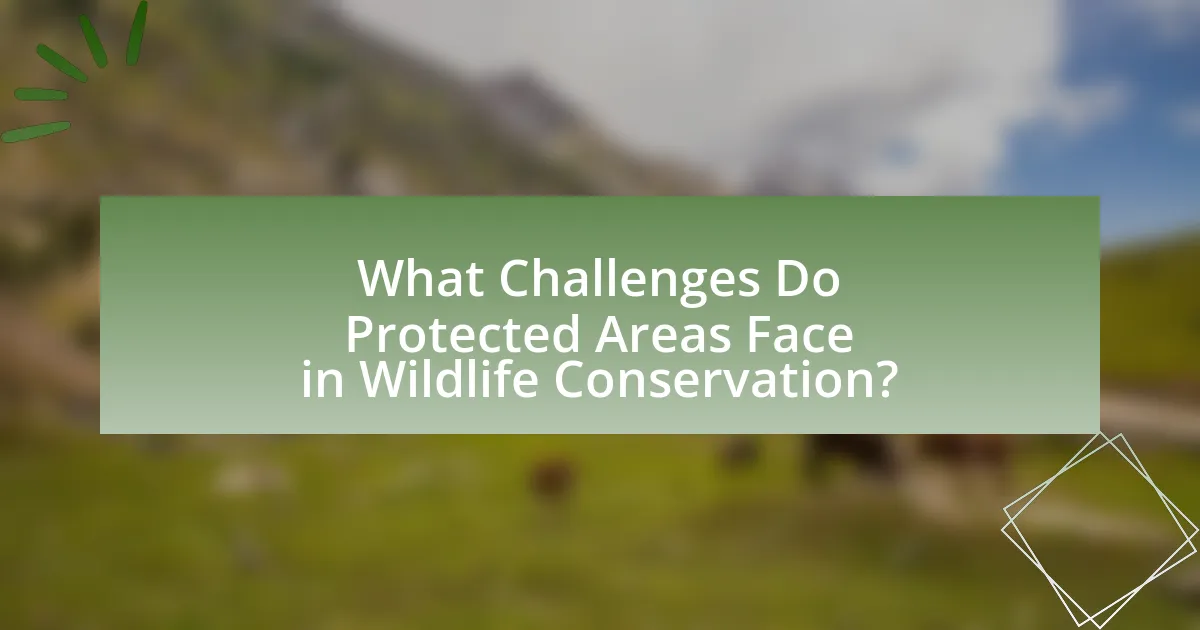
What Challenges Do Protected Areas Face in Wildlife Conservation?
Protected areas face significant challenges in wildlife conservation, including habitat loss, poaching, and climate change. Habitat loss occurs due to agricultural expansion, urban development, and infrastructure projects, which fragment ecosystems and reduce biodiversity. Poaching remains a critical threat, as illegal hunting for wildlife products undermines population stability and recovery efforts. Climate change further exacerbates these issues by altering habitats and species distributions, making it difficult for protected areas to maintain ecological integrity. According to the World Wildlife Fund, over 60% of protected areas are affected by human activities, highlighting the urgent need for effective management strategies to address these challenges.
How does human activity impact Protected Areas?
Human activity significantly impacts Protected Areas by introducing threats such as habitat destruction, pollution, and invasive species. These activities, including agriculture, urban development, and tourism, can lead to fragmentation of ecosystems, which disrupts wildlife populations and their natural behaviors. For instance, a study published in the journal “Conservation Biology” found that agricultural expansion has resulted in the loss of over 50% of natural habitats in some regions, directly affecting biodiversity within Protected Areas. Additionally, pollution from nearby industrial activities can degrade water quality and soil health, further threatening the flora and fauna that these areas aim to protect.
What are the effects of poaching on wildlife within Protected Areas?
Poaching severely impacts wildlife within Protected Areas by reducing animal populations and disrupting ecosystems. For instance, targeted species such as elephants and rhinos face significant population declines due to illegal hunting for ivory and horns, leading to decreased genetic diversity and increased vulnerability to extinction. According to a study published in the journal “Conservation Biology,” poaching has contributed to a 30% decline in African elephant populations over the past decade. Additionally, the removal of key species disrupts food chains and alters habitat dynamics, which can lead to overpopulation of certain species and further ecological imbalance.
How does climate change threaten the integrity of Protected Areas?
Climate change threatens the integrity of Protected Areas by altering ecosystems, disrupting species habitats, and increasing the frequency of extreme weather events. These changes can lead to habitat loss, reduced biodiversity, and challenges in species migration, as many species may not be able to adapt quickly enough to shifting climate conditions. For instance, a study published in “Nature Climate Change” indicates that up to 30% of protected areas may become unsuitable for their current species by 2050 due to rising temperatures and changing precipitation patterns. This loss of habitat integrity undermines the primary purpose of Protected Areas, which is to conserve wildlife and maintain ecological balance.
What role does funding play in the effectiveness of Protected Areas?
Funding is crucial for the effectiveness of Protected Areas, as it directly influences their management, enforcement, and conservation outcomes. Adequate financial resources enable the hiring of trained personnel, implementation of monitoring systems, and development of infrastructure necessary for habitat protection. For instance, a study published in “Conservation Letters” by Geldmann et al. (2013) found that Protected Areas with higher funding levels had better biodiversity outcomes, demonstrating a clear correlation between financial investment and conservation success. Additionally, funding supports community engagement initiatives, which are essential for fostering local stewardship and compliance with conservation regulations.
How can insufficient funding lead to management challenges?
Insufficient funding can lead to management challenges by limiting resources necessary for effective conservation efforts in protected areas. When financial support is inadequate, management teams struggle to implement essential programs such as habitat restoration, species monitoring, and community engagement initiatives. For instance, a study by the World Wildlife Fund indicates that protected areas with budget constraints often experience increased poaching and habitat degradation, as there are fewer personnel and resources available to enforce regulations and maintain ecological integrity. This lack of funding directly impacts the ability to achieve conservation goals, resulting in diminished biodiversity and compromised ecosystem services.
What are potential solutions to improve funding for Protected Areas?
Potential solutions to improve funding for Protected Areas include establishing innovative financing mechanisms, such as payment for ecosystem services, which incentivizes landowners to maintain biodiversity. Additionally, increasing public-private partnerships can leverage private investment for conservation efforts, as evidenced by the success of initiatives like the Nature Conservancy’s collaboration with corporations to fund land protection. Furthermore, enhancing community engagement through ecotourism can generate revenue while promoting conservation, demonstrated by programs in Costa Rica that have significantly boosted local economies and funding for protected areas.
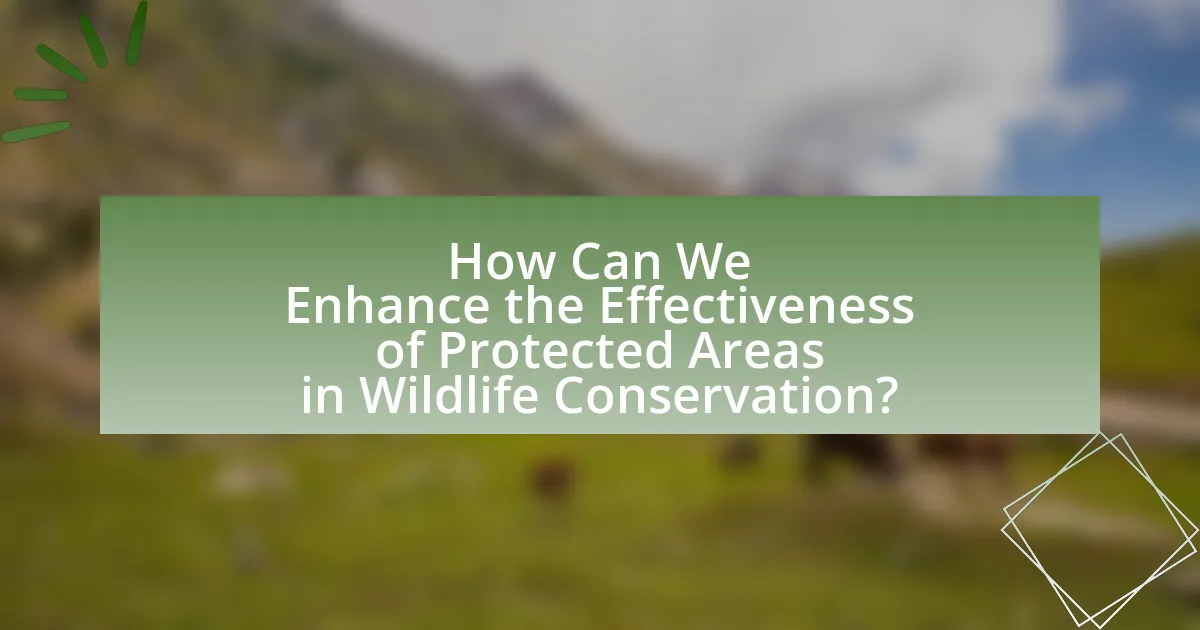
How Can We Enhance the Effectiveness of Protected Areas in Wildlife Conservation?
Enhancing the effectiveness of protected areas in wildlife conservation can be achieved through improved management practices, community engagement, and scientific research. Effective management practices include regular monitoring of wildlife populations and habitats, which allows for adaptive management strategies that respond to changing environmental conditions. Community engagement fosters local stewardship, as involving local populations in conservation efforts has been shown to increase compliance and reduce poaching; for instance, the success of community-based conservation initiatives in Namibia has led to a significant increase in wildlife populations. Additionally, scientific research provides critical data that informs conservation strategies, such as the study published in “Conservation Biology” by Watson et al. (2014), which emphasizes the importance of evidence-based decision-making in protected area management. These combined approaches can significantly enhance the effectiveness of protected areas in conserving biodiversity.
What strategies can be implemented to improve management practices?
Implementing adaptive management strategies can significantly improve management practices in protected areas for wildlife conservation. Adaptive management involves a systematic process of learning from management outcomes and adjusting practices accordingly. For instance, the U.S. National Park Service employs adaptive management to enhance biodiversity by monitoring species populations and habitat conditions, allowing for timely interventions based on data-driven insights. This approach has been shown to increase the effectiveness of conservation efforts, as evidenced by the recovery of several endangered species in national parks. Additionally, stakeholder engagement and collaboration with local communities can enhance management practices by incorporating diverse perspectives and knowledge, leading to more sustainable outcomes.
How can community involvement strengthen Protected Areas?
Community involvement can strengthen Protected Areas by fostering local stewardship and enhancing conservation efforts. When communities actively participate in the management and protection of these areas, they contribute valuable local knowledge and resources, which can lead to more effective conservation strategies. For instance, studies have shown that areas with strong community engagement often experience better biodiversity outcomes, as local residents are more likely to monitor and protect wildlife and habitats. Additionally, community involvement can lead to increased funding and support for conservation initiatives, as local stakeholders advocate for the importance of preserving their natural resources.
What role does technology play in monitoring Protected Areas?
Technology plays a crucial role in monitoring Protected Areas by enabling real-time data collection and analysis. Tools such as satellite imagery, drones, and remote sensing technologies allow conservationists to track wildlife populations, assess habitat conditions, and detect illegal activities like poaching. For instance, the use of satellite imagery has been shown to improve the monitoring of deforestation rates in protected regions, providing critical data that informs management decisions. Additionally, GPS collars on animals facilitate the study of their movements and behaviors, contributing to more effective conservation strategies. These technological advancements enhance the ability to protect biodiversity and ensure the integrity of ecosystems within Protected Areas.
What best practices can be adopted for successful conservation efforts?
Successful conservation efforts can be achieved through the establishment and effective management of protected areas. Protected areas serve as critical habitats for biodiversity, allowing ecosystems to thrive while minimizing human impact. Research indicates that well-managed protected areas can lead to a 50% increase in species populations compared to unprotected regions, as evidenced by a study published in “Nature” by Geldmann et al. (2019), which analyzed over 1,000 protected areas worldwide. Additionally, engaging local communities in conservation initiatives fosters stewardship and enhances compliance with regulations, further supporting biodiversity. Implementing adaptive management practices ensures that conservation strategies remain effective in response to changing environmental conditions, as highlighted by the International Union for Conservation of Nature (IUCN).
How can collaboration between organizations enhance conservation outcomes?
Collaboration between organizations can enhance conservation outcomes by pooling resources, expertise, and data to create more effective conservation strategies. When organizations work together, they can leverage diverse skill sets and knowledge bases, leading to innovative solutions for complex environmental challenges. For instance, joint initiatives can result in comprehensive habitat restoration projects that benefit multiple species, as seen in the partnership between the World Wildlife Fund and local governments in the Amazon, which has led to a significant increase in forest cover and biodiversity. Additionally, collaborative efforts often facilitate better monitoring and enforcement of conservation policies, as demonstrated by the success of transboundary protected areas, where multiple nations coordinate to protect shared ecosystems, resulting in improved wildlife populations and ecosystem health.
What are the key indicators of success for Protected Areas?
Key indicators of success for Protected Areas include biodiversity conservation, habitat integrity, and effective management practices. Biodiversity conservation is measured by the presence and population stability of key species, particularly those that are threatened or endangered. Habitat integrity is assessed through the maintenance of ecosystem functions and the absence of significant degradation, which can be evaluated using metrics such as vegetation cover and water quality. Effective management practices are indicated by the implementation of management plans, stakeholder engagement, and adequate funding, which can be quantified through the assessment of resources allocated and the involvement of local communities in conservation efforts. These indicators collectively demonstrate the effectiveness of Protected Areas in achieving their conservation goals.
